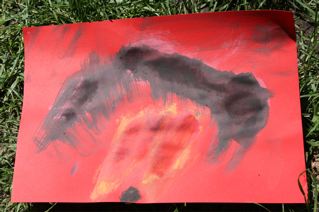Family Brunch unfortunately had to be cancelled at the last minute this week. Taking a cue from the old adage, "When life gives you lemons, make lemonade!", I told the story I had worked on to my own children and husband in a small, intimate and impromptu worship service.
This story is called "The Good Shepherd and the World Communion" and combines the ideas of Jesus as the Good Shepherd in Psalm 23 and John 10 with the liturgical ritual of communion. It is a fairly short text, but loaded with things to think about. It ends with people from all over the world and the children gathering around the Good Shepherd's table.
This was also the first time that I have ever told a Godly Play story in English. That was slightly amusing, because I was translating from the German in my thoughts the entire time. I think it actually helped slow me down and make the whole story more meditative.
It was also a good opportunity to practice the language of silence with my own children. My kids sometimes have difficulty separating Mom from children's pastor and teacher (I am also my son's English teacher at his school!). And as anyone who has ever taught their own children in a group setting knows, your own children can often be the cause of the worst disruptions. So this was a chance to explain again what I expect of them and why.: )
During the Wondering Phase, my children seemed more thoughtful than usual, perhaps because we were at home. I asked three questions:
"Have you ever been near the Good Shepherd's table?"
Here my children had specific memories of being near the Good Shepherd's table not only in our church, but in other churches as well and talked about the different types of bread that were at the Communion table.
"Do you think the people around the table are happy?"
This question about whether the people were happy or not led to a conversation about whether or not the people are always happy when they came to the table. I mentioned that sometimes people come to the table when they are sad and need comfort. Then, one of my children said, "Sometimes people come when they are in trouble and need God to forgive them." What a beautiful thought, that we can come to the Good Shepherd's table anytime and in any state to find what we need . . .
"Have you ever heard the words of the Good Shepherd?"
Here both children said that they didn't hear God with their physical ears. One said she heard Him with the ears of our her heart, and the other child said he saw God with his "third eye" or spiritual eye. We also talked about how we can hear the Good Shepherd through the Bible, other people and nature.
Then, we celebrated feast time with grape juice and spelt crackers. Sometimes the unplanned things in life turn out to be the most fun!
This story is called "The Good Shepherd and the World Communion" and combines the ideas of Jesus as the Good Shepherd in Psalm 23 and John 10 with the liturgical ritual of communion. It is a fairly short text, but loaded with things to think about. It ends with people from all over the world and the children gathering around the Good Shepherd's table.
 |
| Here are the materials for this story. There are two "pastures", a literal one and one in the church. The Good Shepherd leads the sheep out of the stall on the left to his table on the right. |
 |
| At the end of the story, the Good Shepherd and sheep are joined by people from around the world and the children. For info on how I made the materials, click here. |
It was also a good opportunity to practice the language of silence with my own children. My kids sometimes have difficulty separating Mom from children's pastor and teacher (I am also my son's English teacher at his school!). And as anyone who has ever taught their own children in a group setting knows, your own children can often be the cause of the worst disruptions. So this was a chance to explain again what I expect of them and why.: )
During the Wondering Phase, my children seemed more thoughtful than usual, perhaps because we were at home. I asked three questions:
"Have you ever been near the Good Shepherd's table?"
Here my children had specific memories of being near the Good Shepherd's table not only in our church, but in other churches as well and talked about the different types of bread that were at the Communion table.
"Do you think the people around the table are happy?"
This question about whether the people were happy or not led to a conversation about whether or not the people are always happy when they came to the table. I mentioned that sometimes people come to the table when they are sad and need comfort. Then, one of my children said, "Sometimes people come when they are in trouble and need God to forgive them." What a beautiful thought, that we can come to the Good Shepherd's table anytime and in any state to find what we need . . .
"Have you ever heard the words of the Good Shepherd?"
Here both children said that they didn't hear God with their physical ears. One said she heard Him with the ears of our her heart, and the other child said he saw God with his "third eye" or spiritual eye. We also talked about how we can hear the Good Shepherd through the Bible, other people and nature.
Then, we celebrated feast time with grape juice and spelt crackers. Sometimes the unplanned things in life turn out to be the most fun!






















